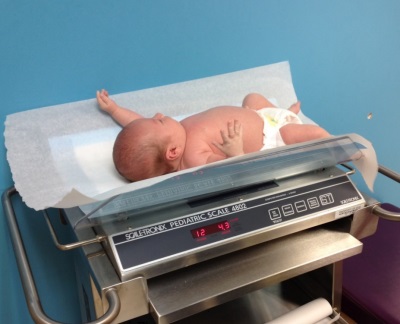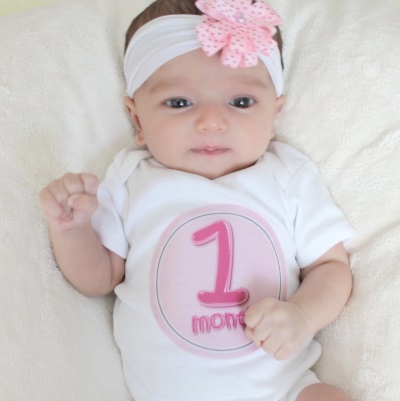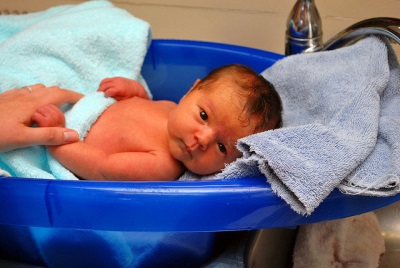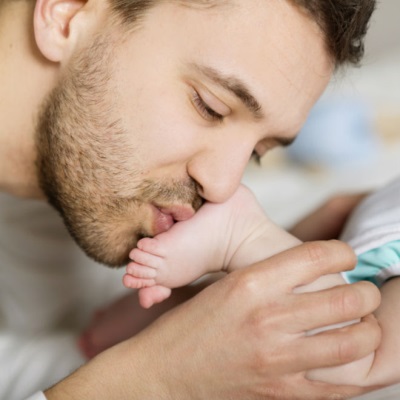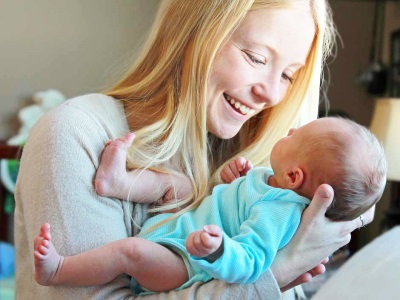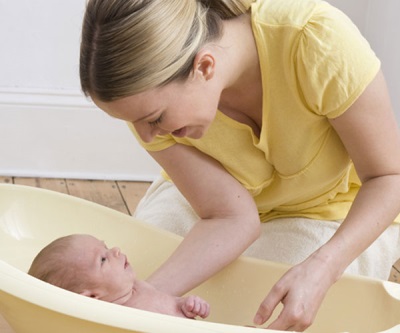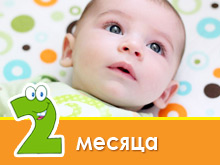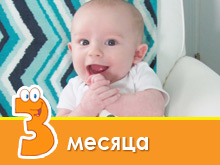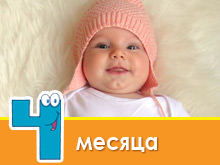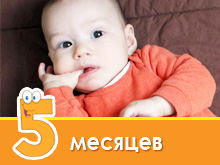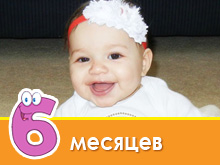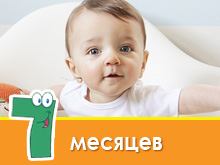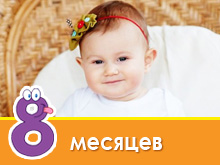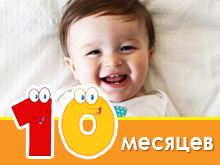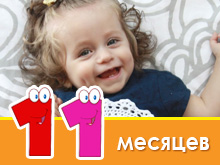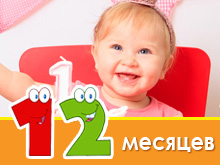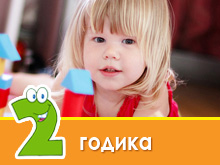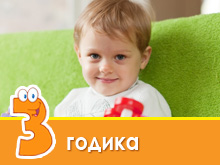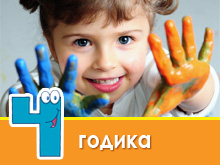Child development in 1 month
The neonatal period is over and the crumb has already settled into a new world for it. What did the child learn in the first month of life, what skills did he begin to possess and how can parents contribute to the further development of the baby in 1 month?
Physical development in 1 month
An average weight gain of a month-old baby compared to birth weight is 600 grams. Baby growth in the first month increases by an average of three centimeters.
These are average indicators and the development of each baby individually, but there are limits to the norm, when going beyond which the child must be examined by a doctor.
The physical indicators of the development of a month-old baby are presented in the following table.
Indicator | Boys in 1-2 months | Girls 1-2 months | Average value in 1 month |
Weight | 3400-5800 g | 3200-5500 g | 4200-4500 g |
Growth | 50.8-58.5 cm | 49.8-57.6 cm | 53.7-54.7 cm |
Head circumference | 34.9-39.6 cm | 34.2-38.9 cm | 36.5-37.3 cm |
Chest circumference | 34.1-38.9 cm | 34-38.1 cm | 36.1-36.5 cm |
What baby can?
Here are the skills that a baby learns by 1 month of age:
- Hold the head. Baby, being in position on the tummy, can lift the head and hold it up to 5 seconds.
- Fixing gaze. The child peers not only at fixed objects and the face of an adult, but also at moving objects, if they are large and bright.
- The development of vision. The baby can already distinguish between red, black, yellow and white, as well as cells and lines. In addition, the baby in 1 month already recognizes mom.
- The reaction to the sound. When the baby hears a loud or harsh sound, it starts or stops. Sometimes the sound scares the baby so much that it makes the baby cry.
- The goo You will hear sounds similar to “gu” or “ha” from the monthly karapuz, so this baby’s first speech is also called agukani.
The fact that the baby should be able to 1 month, see the next video of Nikolai Nikonov - the leading doctor and massage therapist in Russia.
Can a crumb smile?
Conscious smile is one of the most pleasant skills that a child develops during the first month of life. The more often the mother smiles at the baby, the sooner she sees a charming smile in return. In addition, the smile will be accompanied by other manifestations of the revitalization of the baby - the child will move his legs and arms, as well as to roar.
Note that you can see how the newborn smiles, from the first days of life, but the baby’s first smiles are involuntary. First, the mother will notice that the crumb smiles in a dream, a little later - while bathing or after feeding. These are all variants of a physiological smile. But closer to 1 month, the baby's smile appears social content. She becomes a response to contact with a mother or other close person.
Care
Mom should always stay close to the baby and immediately respond to the needs of the little one.
Often take the baby in your arms, not forgetting to support your head, talk to the peanut and do not worry that in this way teach the little one to your hands and grow an egoist. On the contrary, studies have shown that babies, which mothers take less often on their hands, cry more often and longer, trying to attract the attention of mothers. If the baby knows that mom is always there, then he will not scream once again.
Care for baby in 1 month includes the following actions:
- Hygiene procedures - washing, eye and eye care, washing, nail cutting, combing.
- Bathing.
- Walks in the open air.
- Massage.
- Air baths.
When dressing your baby, make sure that your hands are not cold or wet, since babies of 1 month are very sensitive to tactile sensations.
How to promote development?
Since the wakefulness periods of a baby are very small for 1 month, the mother should correctly allocate time so that she can have time and talk with the baby, and carry out hygienic procedures, and massage, swim in the bath, and take a minute to develop the babies. Mom's well-being is also important; therefore, it is necessary to take time and to have a good rest while the baby is sleeping.
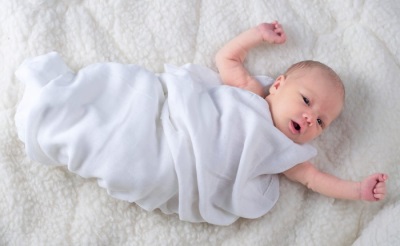
A child of 1 month studies surrounding objects, both immovable and moving, and the sounds of the surrounding world. Which same developing Are classes available at this age? Firstly, communication with the baby for the development of his emotional and mental sphere. Secondly, the stimulation of vision, tactile receptors and hearing of the child. And, thirdly, helping to retain the head, for which the baby is often spread on the tummy and kept in a post.
Here are some actions that will help in the development of a monthly baby:
- To help the baby focus the look, Show the baby a large toy, wait for the baby to look at it, and then slowly move it to the side, ensuring that the baby’s gaze remains focused on the toy.
- Repeat the same with the rattle, which makes quiet sounds. Do this with your baby 1-2 times a day for up to 2 minutes in one session.
- You can also include baby classic music or recording various musical instruments. Let the little one listen to music for up to 10 minutes daily.
- Hang in the crib mobile with large toys (3-4 pieces) and a pleasant melody. You can also lay out the crumbs on developing mat.
- Constantly talk with baby. And do it so that the baby can see your facial expressions. So you will stimulate and hearing the child, and the development of the baby's speech. In response to her mother's gentle speech, the baby will begin to respond faster with a complex of animation and a conscious smile.
Let not only the mom plays with the baby, but also the dad, because the interaction with the baby is different, which allows the crumbs to absorb the best from each of them.
Games in 1 month
For physical development:
- Putting the crumb on the back, take the child by the handles, lift them up by the head, then lower down, then cross on the chest and spread to the sides. With crumbs legs you can imitate movement on a bicycle. During such a gymnastics sing a pleasant song.
- Put the baby on the tummy, show him the toy and lift it up, stimulating the baby to raise his head. You can also put a crumb on your belly and call the baby by name so that the child lifts his head and starts looking at your face. Such exercises will improve the development of his muscles.
- Gently touch the baby while swimming, accompanying such a light massage with a quiet song. After bathing your baby, wrap the baby in a towel, hide your face behind its edge, then look out from behind the towel and say “cuckoo”.
For the development of vision:
- Make a kind of “doll” out of a paper plate. To do this, draw a face and attach a handle to the plate so that it can be held and moved. Show the “doll” to the baby from a distance of 25 cm and wait for the crumb to start watching the plate.
- Bend over the baby to fix his gaze on your face, and then slowly move to the side. The baby will follow you, turning the head.
- For a small toy you need to sew gum and hang the toy over the child. Then make the toy on the elastic band "jump" in front of the kid up and down.Soon the child will not only look at the jumping toy, but also try to grab it with the hands.
- Show your child a bright toy at a distance of 30 cm from his face, then slowly lead the object horizontally. Noticing that the child is looking at the toy, then move it vertically, and in the end move the object in a circle.
- During feeding, place a bright scarf or towel on your shoulder. The kid will look from your face to this bright subject.
For the development of other senses:
- Read children's poems to your child in order to develop crumbs of hearing and sense of rhythm. You can introduce the baby with your favorite rhymes or come up with your own. You can take as a basis any song and change the words in it to your taste.
- Tie to the baby's bootees on the bell. During the movement of the legs, the crumb will hear the ringing and listen to it.
- When the baby is in the crib, talk to the baby while you are moving around the room. This will both stimulate the baby’s hearing and his sight.
- Gently massage on the feet and handles of the baby with each finger. Touch the crumbs not only with your hands, but also with a piece of cotton, a soft brush, a terry cloth, wool or other cloth mitten.
- Dip the cotton balls into unsharp, smelling liquids, such as mint or vanilla eau de toilette. Giving such a baby a ball will stimulate the infant's sense of smell.
The development of the child is promoted by massage. To learn how to do it correctly, see the next video of Nikolay Nikonov.
Water Classes
Among the activities that stimulate the development of infants 1 month, can be called swimming. It can be carried out both in the pool (under the control of the instructor) and in the bath at home. Thanks to the exercises in the water the baby will stimulate the vestibular apparatus. For swimming, purchase a special inflatable circle for the baby that supports the baby under the neck.
Having typed a full bath of warm water, lower the child with the circle into the water and wait until the baby is comfortable. Literally one or two swimming, and the baby will begin to enjoy such activities, and the mother can just watch the crumbs and catch the brightest moments for the photo.
Lower the baby into the water carefully, starting from the heels, taking into account the sensitivity of babies to changes in the temperature of the surrounding world. If the baby reacts negatively to the first swim, try to dip into the bath together with the baby. Lay the baby on your breast, gently water the body of the baby with some water and show the toys.
Show karapuzu that he can push off the legs from the walls of the bath. Unroll the floating baby so that its bent legs have rested against the side and wait until the crumb pushes off and swims back a little. At the opposite edge of the bath, turn the baby around and repeat the exercise.
An interesting exercise for babies of the first month while swimming will be walking on the bottom of the bath. Hold the baby under the arms and tilt forward slightly, stimulating the walking reflex for a few seconds. Next, give the baby a little swim on the back.
Frequent problems
Abnormalities that parents can identify in 1 month:
- Increased or decreased muscle tone of the child. Asymmetry of muscle tone is also possible.
- Jaundice. For some children, it does not pass by the month, which requires consultation with a pediatrician.
- Colic. They appear by the third week of life in many babies and cause great discomfort in the crumbs.
- Insufficient weight gain, which can be associated with both the problems of organizing breastfeeding and diseases of the baby.
For any of these problems, the child must be shown to the doctor by talking about the alarming symptoms.

